- Why
did Guru Nanak travel so much? Which are the prominent places of pilgrimage
that he visited in India and what is their importance in Indic thought?
Guru
Nanak was some traveller. During my India travels found that in number of
places gurdwaras were made because Nanak visited. Nanak’s travels are called Udasis. We present pictures of the
various modern day gurdwaras besides giving importance of pilgrimage towns. Burhanpur
and In some cases Guru Govind Singhji (GGS) also visited same place. Read Nanak’s
First Udasi , Second
Udasi , Third
Udasi , Fourth
Udasi and Fifth
Udasi
1. Burhanpur
There
are two gurdwaras there, one in the town and another on the banks of the river
Tapti.
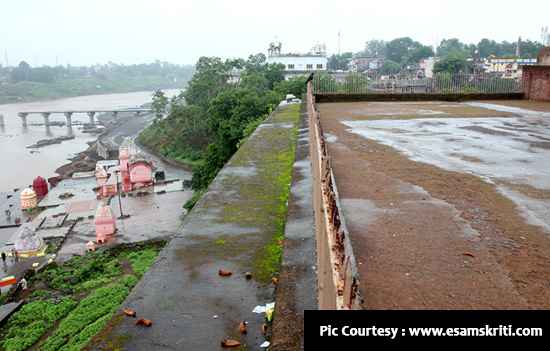 View of Tapti river from Shahi Quila. Behind tree is under construction gurdwara. Left are Ghats. 2018.
View of Tapti river from Shahi Quila. Behind tree is under construction gurdwara. Left are Ghats. 2018.
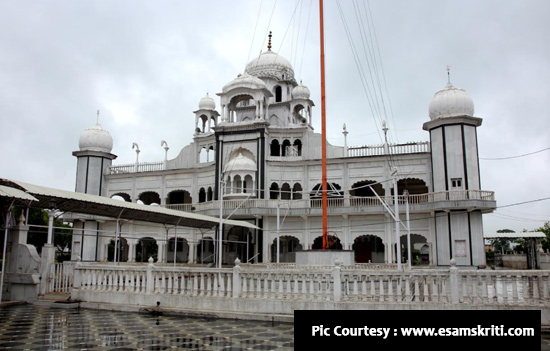 Guru Nanak and GGS visited.
Guru Nanak and GGS visited.It
is said that Nanak visited enroute to Omkareshwar in 1511-12. GGS visited in
1708 enroute to Nanded. According to OutlookIndia,
A handwritten copy of the Guru Granth Sahib (holy book) marked with his seal,
is attributed to him, and carefully preserved here. External
link
But what is
importance of Burhanpur in the pre-Muslim era.
Noted author & travel blogger Anuradha
Goyal wrote in IndiaTales.com, “In the Indian scriptures, Burhanpur is
mentioned as Bhrignapur, taking its name from Bhrigu Rishi who not just did his
Tapa here but also wrote Bhrigu Samhita here on the banks of Tapti River. I
found the name Brahmapuri written at many places but I could not place a temple
dedicated to Brahma here or any reference to him. Tapti is called Suryaputri or
the daughter of Sun.” External
link
To see album
on Burhapur
Today Burhanpur is the base town for Asigarh
Fort. Anuradha Goyal wrote,
“In the known history, Asa Aheer, a local chief of Yadava clan built the fort
in 14th CE. In fact, Asirgarh gets its name from his name. He and his family
were killed by deceit by Faruqi Nasir Khan around 1400 CE.”
This
fort finds a mention in the Mahabharata. It has an excellent Water System and numerous
kunds. To see
album on Asirgarh Fort
2. Omkareshwar Jyotirling
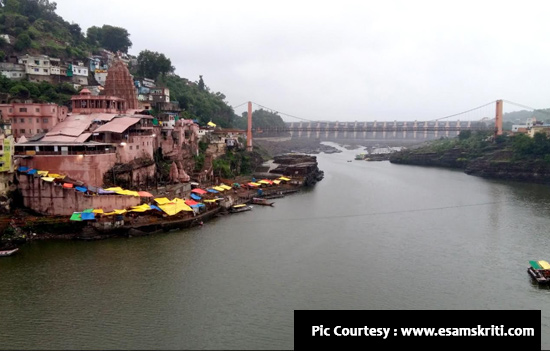 Ma Narmada. On left of pic is gurdwara. It is a small structure
Ma Narmada. On left of pic is gurdwara. It is a small structureTo
see album on Omkareshwar Jyotirling
3. Amarkantak, source of Ma Narmada
 Gurdwara at Amarkantak.
Gurdwara at Amarkantak.
Amarkantak
is the source of Ma Narmada and known as Teerthraj.
It has a Narmada mandir/kund and a Shree Yantra mandir. Kapil Rishi is said to
have stayed here and performed austerities. Sankaracharya visited. He built a
Surya Kund to specify origin of Ma Narmada and installed a murti of Shivji.
Nanak visited for a dialogue with Kabir.
I
reached Amarkantak at about 1.30 am in freezing December. It is at the gurdwara
that I spent the night. Amarkantak has a Jain temple too.
Ramanuja preached the doctrine of salvation
through bhakti, which he made out to be the central teaching of the Upanishads,
the Gita and Brahmasutra. “His influence is seen throughout the later period
through Vallabhacharya, Chaitanya Mahaprabhu, Ramananda, Kabir, Guru Nanak, and
others being largely indebted to his theistic idealism.” 1 Pg. 337
Also see albums Amarkantak
and Temples
of Amarkantak
4. Ayodhya
Nanak visited Ayodhya. Supreme Court referred to visit in its order on Ram Mandir.
.jpg) Way to Ram Mandir. Pic by Bindu Krishnan.
Way to Ram Mandir. Pic by Bindu Krishnan.
Also read The
land of 7000 temples is Ayodhya n Ramayana
in Southeast Asia
5 Pushkar
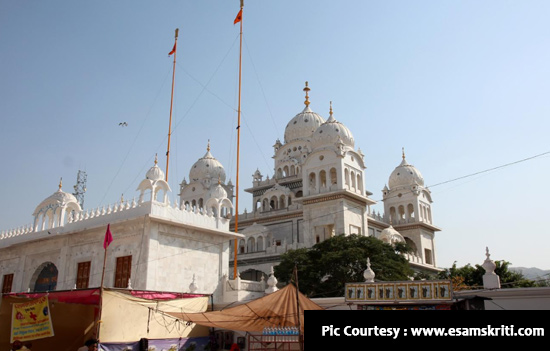 Gurdwara at Pushkar.
Gurdwara at Pushkar.
Pushkar
is known for its Holy Sarovar, Brahma Temple and annual Mela that ends on Kartik
Purnima. The Sarovar has 52 ghats and about 400 temples. A trip is incomplete
without a dip in the Sarovar. It is a must do pilgrimage for Hindus.
Guru Nanak visited Pushkar in 1509 AD to have a holy dip in Pushkar Lake on the full moon night of Kartik Purnima, his birthday. Guru Govind Singh visited on Kartik Purnima in 1706 A.D. He held a meeting with Rajput rulers to enlist their support for fighting Mughal rule. A small gurdwara was constructed in the early 19th century to commemorate their visits. What you see was made about 2005 and locals said was funded by NRI's from the U.S.
To
see album on Kartik Purnima in Pushkar
6 Rameshwaram Jyotirling
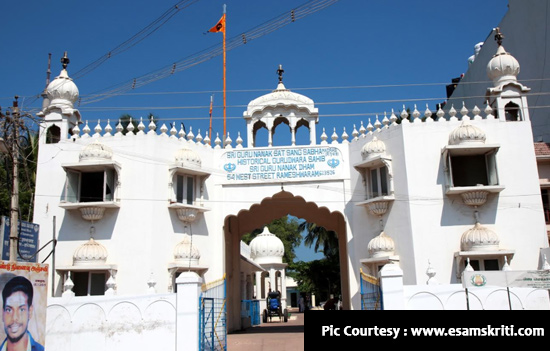 Gurdwara at Rameshwaram.
Gurdwara at Rameshwaram.
Nanak
visited Rameshwaram enroute to Sri Lanka.
To see
albums on Rameshwaram , Ramayana
around Rameshwaram , Dhanushkodi
Island Rameshwaram
7 Jabalpur
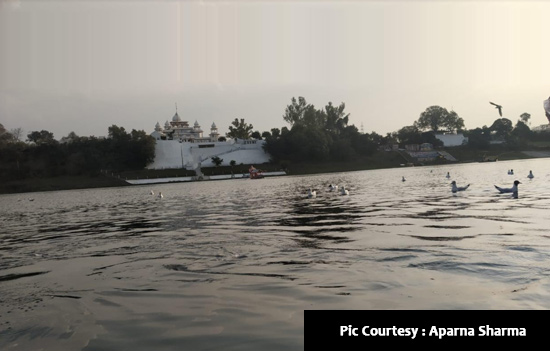 View of Narmada at Gwarighat. Gurdwara across river.
View of Narmada at Gwarighat. Gurdwara across river.
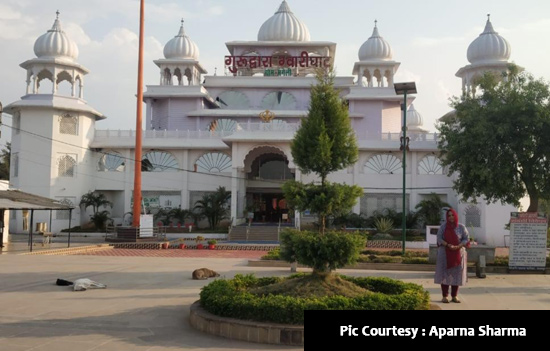 Inside the gurdwara premises.
Inside the gurdwara premises.
Nanak
visited. The evening aarti with diyas (lamps) reminds one of the Ganga Aarti in
Haridwar. According to Wikipedia, “It is
associated with the Puranas. Also, due to the presence of Narmada Sidh
Kund, near Uma Ghat, wherein renowned Rishis performed Tapas.”
To see albums of Marble
Rocks Jabalpur , Chausath
Yogini Temple
8 Lakhpat, Gujarat
 From Lakhpat Nanak crossed to Somiani port in Sindh & then to Mecca.
From Lakhpat Nanak crossed to Somiani port in Sindh & then to Mecca.
 Charan Paduka Khadavas, wooden footwear of Guru Nanak & son Baba Srichand.
Charan Paduka Khadavas, wooden footwear of Guru Nanak & son Baba Srichand.
“Guru Nanak stayed in a house on this site on his way to and from Mecca. Later his host's descendant established a Tikana
(seat) a Udasi panth. The panth was founded in the 16th century by Nanak's son Baba Srichand.” Since Nanak visited, it has become a place of pilgrimage.
To see
pictures of Lakhpat Gurudwara and Lakhpat
Fort
9 Haridwar
 Gyan Godri Sahib Gurudwara Haridwar. Pic from net.
Gyan Godri Sahib Gurudwara Haridwar. Pic from net.
Haridwar
or the gateway to the Gods is one of the four towns that hosts the Kumbh Mela.
It also hosts the Kanwar mela every year and has numerous temples and ashrams.
“The Panch Tirth or the five pilgrimages are located within the periphery of
Haridwar. Source
10 Puri
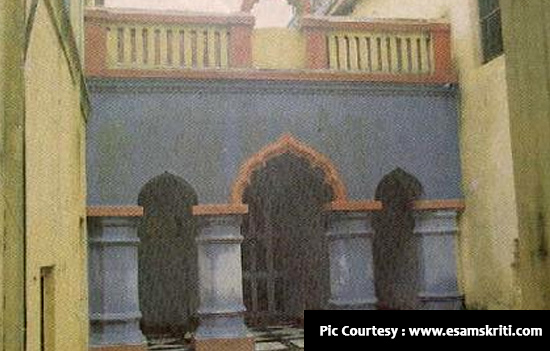 Gurdwara Mangumath. Pic from net.
Gurdwara Mangumath. Pic from net.
Guru
Nanak visited Puri twice. Once in 1508 and again in 1510 when he could eventually
meet Chaitanya Mahaprabhu.
Note
that one of the ‘Panch Pyare or Five Beloved Ones’ who were baptised by Guru
Govind Singhji on March 30, 1699 was from Puri. His name was Himmat Chand Kahar
later renamed as Bhai Himat Singh Ji.
Bhai
Almast, a notable Udasi preacher of the 17th century built Mangumath
Ashram now called Mangumath Gurdwara. “The great saint of Orissa and lyric
poet Bhagat Jaidev finds a place of eminence for his hymns in the Guru Granth
Sahib.” Source
The
Puri Temple must be so revered that Maharaja Ranjit Singh, according to scholar
Dr Satish Kapoor, “wished to donate the Koh-i-noor diamond (which he
had obtained from Shah Shuja, the fugitive Amir of Kabul) to the Jagannath
temple, Puri. His last wish was never carried out and the invaluable jewel
finally passed on to the British.” Source
Also read Maharaja
Ranjit Singh-The Lion of Punjab
11 Arunachal Pradesh
 Nanak visited enroute to Tibet.
Nanak visited enroute to Tibet.
Even today, this place, near Bumla Border with Tibet, is difficult to reach. Imagine what it was like centuries ago. Nanak was going to Tibet/China where many Indian scholars had gone earlier. He visited Mount Kailash (abode of Shiva) and Mansrovar (devotees go there to this day).
To see pictures of Bumla Border
13 Leh
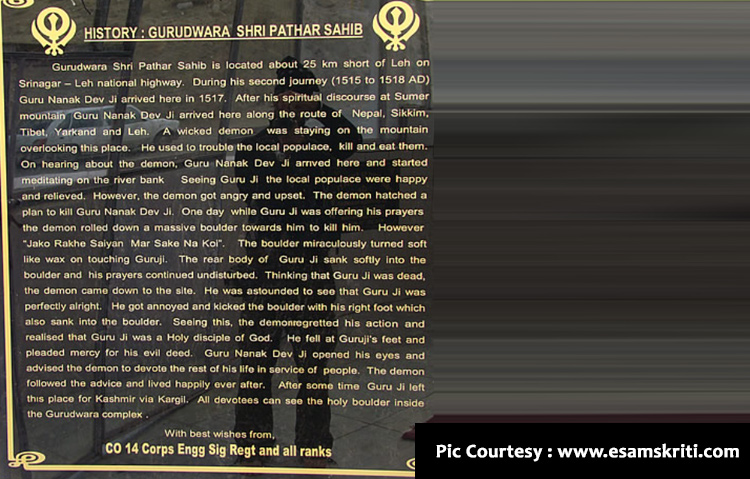 Read story in board.
Read story in board.
It
is called Gurudwara Pathar Saheb. Nanak came here in 1517.
14 Manikaran
Nanak
visited Manikaran, i.e. known for its Shiv Mandir and Hot Water Springs, for meditation.
 Shiv Pratima outside temple. U can see the steam from springs. 2016.
Shiv Pratima outside temple. U can see the steam from springs. 2016.
To see
album on Manikaran
Today
Manikiran attracts large number of Sikh devotees.
This is what I gathered during my visit. Param Pujya Shri Sant Narayan Hari ji Maharaj meditated here and i.e. how the DERA came into being (now Gurdwara). Today it is run by his daughter and son-in-law Baba Shri Ram. Inside the dera pillars have pics of Ma Durga and Shri Krishna.
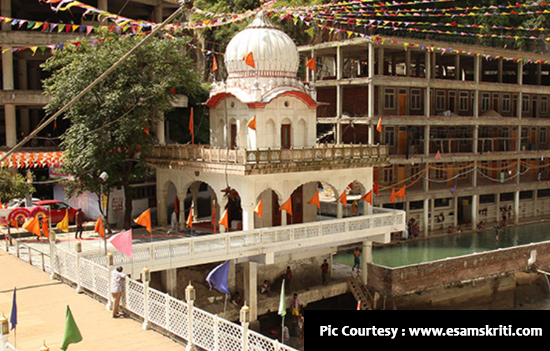 Bridge takes you from dera to opposite side. White dome structure is dedicated to Sant Narayan Hari ji.
Bridge takes you from dera to opposite side. White dome structure is dedicated to Sant Narayan Hari ji.Extreme
left is a multi-level car park. Right of pic are newly made rooms. The Shiv
Mandir and original dera are on opposite side. A pipe takes hot water to this
side where is a tank, see centre of pic. This side is very touristy. On the
dera side there is a seven storied structure with rooms.
Why did Nanak travel so much including prominent Hindus places
of pilgrimage?
Was
he trying to emulate Sankaracharya who, centuries before, travelled throughout
India and had debates with scholars?
Also
read
Acharya
Sankara-Delineator of India
Was
Nanak trying to understand Bharat through these travels, as Swami Vivekananda
did centuries later? Unlikely, because not heard of his writings on India. If
someone can throw light happy to stand corrected.
Actually,
Nanak wished to examine actual working of religions at great centres and give
his own message of love and peace. For this he travelled, south for seeing
Buddhist and Jain places of note-north to examine Sidh maths or places of famous states in Kashmir and Himalayas-west
to study Islam. 2 Pg. 656
It is worth recalling thoughts of K M Munshiji, founder of Bharatiya Vidya Bhavan, “The universal urge which they provided to go on a pilgrimage, generation after generation which were conceived as physical manifestations of the Land of Dharma, also kept alive an emotional awareness of unity and sanctity.” It was at pilgrimage towns that scholars, mostly, engaged in debates and shared knowledge on spiritual matters. Also,
most pilgrimage towns have very strong vibrations and levels of spiritual
energy. They impact devotees, who visit, in different ways. It could be another
reason for visit, the extent of impact is personal and shall not be in public
domain.
13 Mandi, Himachal Pradesh
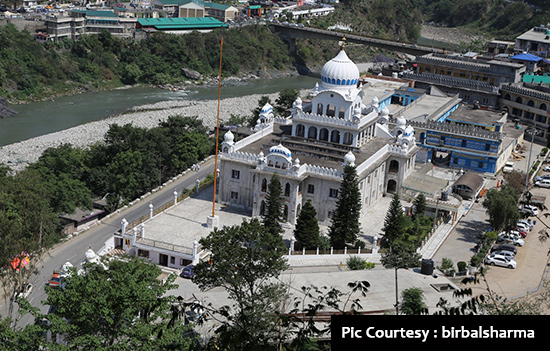 Gurdwara in Mandi.
Gurdwara in Mandi.
Monika Sharma wrote,
“Mandi is home to app. 100 temples, referred as Chhoti Kashi and is considered Shiv
Nagri (town of Lord Shiva) by locals. Its famous temples include Bhoot Nath
Mandir, Ekadashi Rudra Mandir and Tarna Mata Mandir.”
“Sri Guru Govind Singh Ji came to visit Mandi at the invitaion of Mandi's ruler Raja Sidh Sen and stayed for a little over six months. Although the Raja invited Guruji to stay in his palace, Guruji set up tents on the bank of the nearby River Beas. Gurdwara Sri Padal Sahib marks the location of Guruji’s camp.” Source
Note, “The Sikhs came to the Shivalik Hills, in
Himachal Pradesh in 1695, at the invitation of the ruler of Sirmaur, to help
him fight the Mughals. Guru Govind Singh with his army, settled in Paonta Sahib
in the foothills.” Source
14 Rewalsar, Himachal Pradesh
 Lake Kunt Bhayo
with Padmasambhava icon on the right. Pic Vikram Achreja.
Lake Kunt Bhayo
with Padmasambhava icon on the right. Pic Vikram Achreja.
According to tradition the great teacher and "tantric", Padmasambhava used his enormous powers to take flight to Tibet from Rewalsar. It was under Padmasambhava's influence that Mahayana Buddhism took root in Tibet and at Rewalsar waters, his spirit is said to reside in the tiny island of floating reed that drift over the waters. Guru Govind Singhji spent a month here as well.
The gurdwara at Rewalsar was built in 1930 under the patronage of Raja Joginder Sen of Mandi and with the humble efforts of Dewan Nath, Chief Minister of Mandi State and Dr Tehl Singh. Guruji stayed here for a month and held meeting with the hill Rulers -'the Bai-Dhar Rajas' -to evolve a program in his ongoing fight with Aurangzeb.
Rewalsar
has three Hindu temples which are dedicated to Lord Krishna, Lord Shiva and
sage Lomas. The Lake of Kunt Bhayo (1750 m above sea level) lies above Rewalsar.
To see
album on Rewalsar , To read About
history in more detail
Reference
1. The History and Culture of Indian People Vol. 5
published by Bharatiya Vidya Bhawan.
2. The History and Culture of
Indian People Vol 7 published by Bharatiya Vidya Bhawan
Also read
1.
Did
Sikhs save Hinduism and Hindus?
2.
Life
of Ramanuja
3.
Unity
between Sanatan and Sikh Dharma
4.
Album
on Hari Mandir
5.
Album on Nankana
Sahib
6.
San Jose
Gurdwara California
7.
Why
do Sikhs wear Turbans